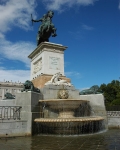Monument to Philip IV of Spain
Archaeology »
Archaeological Monuments » Monument to Philip IV of Spain
Monument to Philip IV of Spain - Spain
Monument to Philip IV of Spain is located in Madrid.
Monument to Philip IV of Spain monument was established on 19th Century.
Primary threats to Monument to Philip IV of Spain :
The Monument to Philip IV or Fountain of Philip IV is a memorial to Philip IV of Spain in the centre of Plaza de Oriente in Madrid.
Historical facts of Monument to Philip IV of Spain :
- The Monument to Philip IV of Spain, also known as the Statue of Philip IV or the Equestrian Statue of Philip IV, is a historical monument located in Plaza de Oriente, Madrid, Spain. Erected in the 17th century, the statue commemorates the reign of Philip IV, one of Spain's most influential monarchs. Here are some historical facts about the Monument to Philip IV of Spain:
- Construction and Inauguration : The construction of the Monument to Philip IV began in 1621, shortly after the death of the king. The statue was commissioned by Philip IV's son and successor, Philip IV, and completed in 1640. It was inaugurated on November 17, 1665, during the reign of Charles II.
- Sculptor : The statue was sculpted by the renowned Italian artist Pietro Tacca. Tacca was a disciple of Giambologna and is known for his mastery of equestrian sculptures. The Monument to Philip IV is considered one of his most significant works.
- Equestrian Statue : The monument features an impressive equestrian statue of Philip IV, depicting him on horseback. The king is portrayed wearing armor and holding a baton in his right hand, symbolizing his military power and authority.
- Symbolism : The Monument to Philip IV represents the power and prestige of the Spanish monarchy during the 17th century. It reflects the royal patronage of the arts and the monarch's desire to project an image of strength and authority.
- Plaza de Oriente : The monument is situated in Plaza de Oriente, a public square located in front of the Royal Palace of Madrid. It was originally designed as a formal garden during the reign of Joseph Bonaparte, but its current layout and landscaping were established in the 19th century.
- Historical Context : Philip IV reigned over Spain from 1621 to 1665, a period known as the Spanish Golden Age. His reign was marked by political, economic, and cultural developments, including significant patronage of the arts. Philip IV was a notable supporter of artists, writers, and musicians, and his court was renowned for its artistic brilliance.
- Restoration : Over the years, the Monument to Philip IV underwent several restorations to preserve its structural integrity and aesthetic appeal. Notably, a major restoration took place in the early 20th century, under the direction of architect Ricardo Velázquez Bosco.
- Neoclassical Surroundings : The monument is surrounded by a neoclassical-style garden, which enhances its visual impact. The garden features symmetrical pathways, manicured hedges, and statues of various Spanish monarchs, contributing to the grandeur and elegance of the plaza.
- Cultural Landmark : The Monument to Philip IV has become an iconic symbol of Madrid and an important cultural landmark. It is a popular tourist attraction, drawing visitors who admire its artistic and historical significance, as well as its prominent location near the Royal Palace.
- Historical Legacy : The Monument to Philip IV serves as a reminder of Spain's rich history and its influential monarchy. It embodies the legacy of Philip IV, a monarch who left a lasting impact on Spanish politics, arts, and culture during a time of great prominence for the nation.
- In conclusion, the Monument to Philip IV of Spain in Plaza de Oriente is a historical monument that pays tribute to the reign of Philip IV, an influential monarch of Spain. The equestrian statue sculpted by Pietro Tacca represents the power and authority of the Spanish monarchy. Situated in a neoclassical-style garden, the monument is a cultural landmark and a testament to Spain's rich history and artistic heritage.

